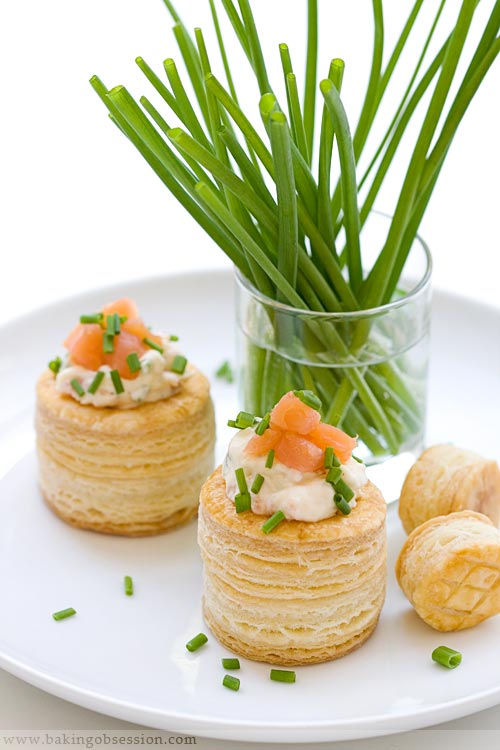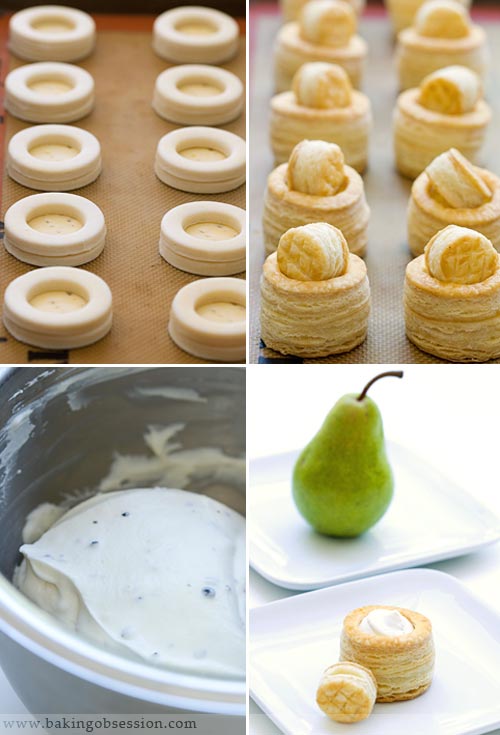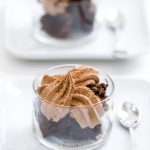
September Daring Bakers’ challenge is up. This time it’s classic puff pastry and vols-au-vent – flaky tartlets that can be filled with at least a thousand possible sweet or savory fillings. Only, I act as usual. First, being overwhelmed with different ideas, I decide to wait until my mind is made up. Then, I wait for the weather to become a bit cooler. And finally, when the weather is as hot as never, and the due date is tomorrow, I roll up my sleeves and get to work proceeding with the simplest solution.
I made one sweet and another savory vols-au-vent.
- Sweet: peppery ricotta/mascarpone mousse with Bartlett pears, sautéed in butter, honey, and vanilla
- Savory: smoked salmon mascarpone mousse
Yep, mascarpone is everywhere. I was utilizing the freshly made cheese; it is only wonderful when super-fresh.

The September 2009 Daring Bakers’ challenge was hosted by Steph of A Whisk and a Spoon who chose this French treat, Vols-au-Vent based on the puff pastry recipe by Michel Richard from the cookbook “Baking with Julia” by Dorie Greenspan.
For the puff pastry dough:
- Makes 2 ½ pounds dough
- 2 ½ cups (12.2 oz/ 354 g) unbleached all-purpose flour
- 1 ¼ cups (5.0 oz/ 142 g) cake flour
- 1 tbsp. salt (you can cut this by half for a less salty dough or for sweet preparations)
- 1 ¼ cups (10 fl oz/ 300 ml) ice water
- 1 pound (16 oz/ 454 g) very cold unsalted butter
- Plus extra flour for dusting work surface
For the sweet peppery ricotta/mascarpone mousse and pear topping:
Makes enough to fill about two dozen of 2-inch shells
- ½ cup fresh whole milk ricotta cheese
- ¼ cup mascarpone chees
- ¼ cup confectioners’ sugar, sifted
- 1/8 tsp salt
- ¼ tsp pure vanilla extract
- Zest of ½ lemon
- ½ tsp black peppercorn, very coarsely crushed
- ¼ cup whipping cream, cold
- 2 tbsp unsalted butter
- 1 tbsp light brown sugar
- 1 tbsp honey
- ¼ vanilla bean, sliced lengthwise, seeds scraped out
- 2 ripe but firm pears, peeled, cored and diced
- ½ tbsp brandy
- 2 tsp fresh lemon juice
For the smoked salmon mascarpone mousse:
Makes enough to fill about two dozen of 2-inch shells
- 6 oz smoked salmon, divided
- ¾ cup mascarpone cheese
- ¼ cup + 2 tbsp sour cream, divided
- 1 hard boiled egg yolk, put through a fine-mesh strainer
- 2 tsp horseradish
- ½ tsp Dijon mustard
- 1 tbsp fresh lemon juice
- ¼ cup finely chopped chives + more for garnish
- Salt and freshly ground pepper to taste
- ¼ cup whipping cream, cold
Mix the dough:
Check the capacity of your food processor before you start. If it cannot hold the full quantity of ingredients, make the dough into two batches and combine them.
Put the all-purpose flour, cake flour, and salt in the work bowl of a food processor fitted with a metal blade and pulse a couple of times just to mix. Add the water all at once, pulsing until the dough forms a ball on the blade. The dough will be very moist and pliable and will hold together when squeezed between your fingers. (Actually, it will feel like Play-Doh.)
Remove the dough from the machine, form it into a ball, with a small sharp knife, slash the top in a tic-tac-toe pattern. Wrap the dough in a damp towel and refrigerate for about 5 minutes.
Meanwhile, place the butter between 2 sheets of plastic wrap and beat it with a rolling pin until it flattens into a square that’s about 1″ thick. Take care that the butter remains cool and firm: if it has softened or become oily, chill it before continuing.
Incorporate the butter:
Unwrap the dough and place it on a work surface dusted with the all-purpose flour (a cool piece of marble is the ideal surface for puff pastry) with your rolling pin (preferably a French rolling pin without handles), press on the dough to flatten it and then roll it into a 10″ square. Keep the top and bottom of the dough well floured to prevent sticking and lift the dough and move it around frequently. Starting from the center of the square, roll out over each corner to create a thick center pad with “ears,” or flaps.
Place the cold butter in the middle of the dough and fold the ears over the butter, stretching them as needed so that they overlap slightly and encase the butter completely. (If you have to stretch the dough, stretch it from all over; don’t just pull the ends) you should now have a package that is 8″ square.
To make great puff pastry, it is important to keep the dough cold at all times. There are specified times for chilling the dough, but if your room is warm, or you work slowly, or you find that for no particular reason the butter starts to ooze out of the pastry, cover the dough with plastic wrap and refrigerate it. You can stop at any point in the process and continue at your convenience or when the dough is properly chilled.
Make the turns:
Gently but firmly press the rolling pin against the top and bottom edges of the square (this will help keep it square). Then, keeping the work surface and the top of the dough well floured to prevent sticking, roll the dough into a rectangle that is three times as long as the square you started with, about 24″ (don’t worry about the width of the rectangle: if you get the 24″, everything else will work itself out.) With this first roll, it is particularly important that the butter be rolled evenly along the length and width of the rectangle; check when you start rolling that the butter is moving along well, and roll a bit harder or more evenly, if necessary, to get a smooth, even dough-butter sandwich (use your arm-strength!).
With a pastry brush, brush off the excess flour from the top of the dough, and fold the rectangle up from the bottom and down from the top in thirds, like a business letter, brushing off the excess flour. You have completed one turn.
Rotate the dough so that the closed fold is to your left, like the spine of a book. Repeat the rolling and folding process, rolling the dough to a length of 24″ and then folding it in thirds. This is the second turn.
Chill the dough:
If the dough is still cool and no butter is oozing out, you can give the dough another two turns now. If the condition of the dough is iffy, wrap it in plastic wrap and refrigerate it for at least 30 minutes. Each time you refrigerate the dough, mark the number of turns you’ve completed by indenting the dough with your fingertips. It is best to refrigerate the dough for 30 to 60 minutes between each set of two turns.
The total number of turns needed is six. If you prefer, you can give the dough just four turns now, chill it overnight, and do the last two turns the next day. Puff pastry is extremely flexible in this regard. However, no matter how you arrange your schedule, you should plan to chill the dough for at least an hour before cutting or shaping it.
Form and bake the vols-au-vent:
Yield: 1/3 of the puff pastry recipe above will yield about 8-10 1.5” vols-au-vent or 4 4” vols-au-vent
In addition to the equipment listed above, you will need some egg wash (1 egg or yolk beaten with a tablespoon of water or milk)
Line a baking sheet with parchment or silicone mat and set aside.
Using a knife or metal bench scraper, divided your chilled puff pastry dough into three equal pieces. Work with one piece of the dough, and leave the rest wrapped and chilled. (If you are looking to make more vols-au-vent than the yield stated above, you can roll and cut the remaining two pieces of dough as well…if not, then leave refrigerated for the time being or prepare it for longer-term freezer storage. See the “Tips” section below for more storage info.)
On a lightly floured surface, roll the piece of dough into a rectangle about 1/8 to 1/4-inch (3-6 mm) thick. Transfer it to the baking sheet and refrigerate for about 10 minutes before proceeding with the cutting.
(This assumes you will be using round cutters, but if you do not have them, it is possible to cut square vols-au-vents using a sharp chef’s knife.) For smaller, hors d’oeuvre sized vols-au-vent, use a 1.5” round cutter to cut out 8-10 circles. For larger sized vols-au-vent, fit for a main course or dessert, use a 4” cutter to cut out about 4 circles. Make clean, sharp cuts and try not to twist your cutters back and forth or drag your knife through the dough. Half of these rounds will be for the bases, and the other half will be for the sides. (Save any scrap by stacking—not wadding up—the pieces…they can be re-rolled and used if you need extra dough. If you do need to re-roll scrap to get enough disks, be sure to use any rounds cut from it for the bases, not the ring-shaped sides.)
Using a ¾-inch cutter for small vols-au-vent, or a 2- to 2.5-inch round cutter for large, cut centers from half of the rounds to make rings. These rings will become the sides of the vols-au-vent, while the solid disks will be the bottoms. You can either save the center cut-outs to bake off as little “caps” for you vols-au-vent, or put them in the scrap pile.
Dock the solid bottom rounds with a fork (prick them lightly, making sure not to go all the way through the pastry) and lightly brush them with the egg wash. Place the rings directly on top of the bottom rounds and very lightly press them to adhere. Brush the top rings lightly with egg wash, trying not to drip any down the sides (which may inhibit rise). If you are using the little “caps,” dock and egg wash them as well.
Refrigerate or freeze the assembled vols-au-vent on the lined baking sheet while you pre-heat the oven to 400ºF (200ºC). (You could also cover and refrigerate them for a few hours at this point.)
Once the oven is heated, remove the sheet from the refrigerator and place a silicon baking mat (preferred because of its weight) or another sheet of parchment over the top of the shells. This will help them rise evenly. Bake the shells until they have risen and begin to brown, about 10-20 minutes depending on their size. Reduce the oven temperature to 350ºF (180ºC), and remove the silicon mat or parchment sheet from the top of the vols-au-vent. If the centers have risen up inside the vols-au-vent, you can gently press them down. Continue baking (with no sheet on the top) until the layers are golden, about 15-20 minutes more. (If you are baking the center “caps” they will likely be finished well ahead of the shells, so keep an eye on them and remove them from the oven when browned.)
Remove to a rack to cool. Cool to room temperature for cold fillings or to warm for hot fillings.
Fill and serve.
Although they are at their best filled and eaten soon after baking, baked vols-au-vent shells can be stored airtight for a day.
Shaped, unbaked vols-au-vent can be wrapped and frozen for up to a month (bake from the frozen, egg-washing them first).
Make the sweet peppery ricotta/mascarpone mousse and pear topping:
Process the ricotta in a food processor until smooth. Add the mascarpone, confectioners’ sugar, vanilla, the lemon zest and pulse to combine. Transfer to a bowl and stir in the cracked pepper.
Whip the cream until medium-firm peaks form. With a rubber spatula, gently fold about a quarter of the whipped cream into the ricotta mixture, then fold in the rest of the cream. Cover the bowl and refrigerate while sautéing the pears.
Melt the butter in a large skillet over medium heat. Add the sugar, honey, vanilla bean and seeds and stir for a minute. Add the pears and cook, stirring often, until the sauce is reduced to a thick glaze and pears are translucent, about 10 minutes. Stir in the brandy and lemon juice; take off the heat. Cool until barely warm before topping the ricotta mousse.
When ready to assemble (right before or very close to the serving time), transfer the mousse into a piping bag fitted with a large plain tip. Fill the vols-au-vent cavities with the chilled mousse and then top generously with the slightly warm pears. Eat immediately.
Make the smoked salmon mascarpone mousse:
Chop the salmon finely. Reserve about 2 oz (one third) for the garnish.
In a small bowl, beat the mascarpone and ¼ cup of sour cream with an electric mixer until smooth. Beat in the yolk, horseradish, Dijon mustard, lemon juice. Stir in 4 oz of chopped salmon and chives. Season generously with freshly ground black pepper and salt (if necessary).
In another small bowl, combine the whipping cream and the remaining 2 tbsp of sour cream. Whip with the electric mixer until medium-firm peaks form. With a rubber spatula, gently fold about a quarter of the whipped cream into the salmon mixture, then fold in the rest of the cream.
Fill the vols-au-vent with the salmon mousse, top with the reserved salmon, sprinkle with some chives and serve.



June 9, 2022 at 9:06 pm
pourquoi mon vol au van du form vous pourrai mes donner une réponse svp
December 30, 2017 at 8:49 pm
can vol au vents be frozen after cooked? Can you also make the vol au vents add the filling then freeze, if so for how long?
January 20, 2011 at 4:01 pm
i SO LOVE your gorgeous photos!!!! Makes the food oh SO YUMMY looking!! (^_^)
November 11, 2009 at 2:45 am
it looks amazing. These are so wonderful!.
October 26, 2009 at 5:50 am
Lovely photos! So professionally done.
October 25, 2009 at 7:26 pm
gorgeous photos and inspirational recipe, as always!